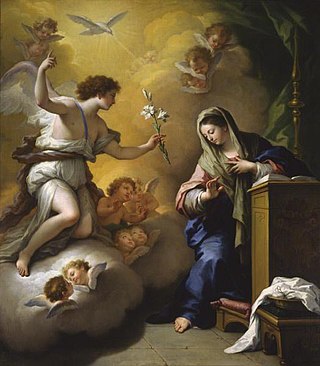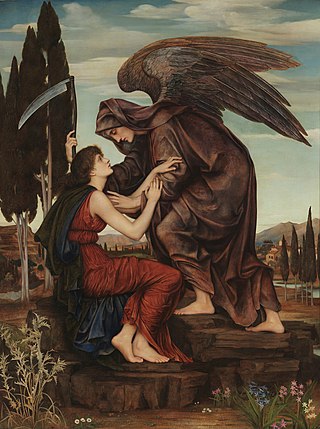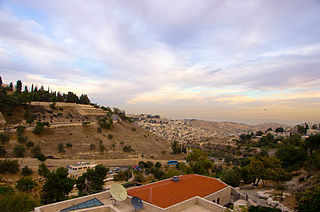
In Greek mythology, Tartarus is the deep abyss that is used as a dungeon of torment and suffering for the wicked and as the prison for the Titans. Tartarus is the place where, according to Plato's Gorgias, souls are judged after death and where the wicked received divine punishment. Tartarus appears in early Greek cosmology, such as in Hesiod's Theogony, where the personified Tartarus is described as one of the earliest beings to exist, alongside Chaos and Gaia (Earth).

The Acheron is a river in the Epirus region of northwest Greece. It is 52 km (32 mi) long, and its drainage area is 705 km2 (272 sq mi). Its source is near the village Zotiko, in the southwestern part of the Ioannina regional unit. The Acheron flows into the Ionian Sea in Ammoudia, near Parga.

Archangels are the second-lowest rank of angel in the Christian hierarchy of angels, put forward by Pseudo-Dionysius the Areopagite in the 5th or 6th century in his book De Coelesti Hierarchia. The word is usually associated with the Abrahamic religions; very similar beings exist in several other religions.

In Christian theology, the Harrowing of Hell is the period of time between the Crucifixion of Jesus and his resurrection. In triumphant descent, Christ brought salvation to the souls held captive there since the beginning of the world.

Azrael is the angel of death in some Abrahamic religions, namely Islam and Christian popular culture.

"Turtles all the way down" is an expression of the problem of infinite regress. The saying alludes to the mythological idea of a World Turtle that supports a flat Earth on its back. It suggests that this turtle rests on the back of an even larger turtle, which itself is part of a column of increasingly larger turtles that continues indefinitely.

Uriel, Auriel or Oriel is the name of one of the archangels who is mentioned in the post-exilic rabbinic tradition and in certain Christian traditions. He is well known in the Russian Orthodox tradition and in folk Catholicism and recognised in the Anglican Church as the fourth archangel. He is also well known in European esoteric medieval literature. Uriel is also known as a master of knowledge and archangel of wisdom.

Cecil Turtle is a fictional character in the Warner Bros. Looney Tunes and Merrie Melodies series of films. Though he made only three theatrical appearances, Cecil has the unusual distinction in that he is one of the very few characters who were able to outsmart Bugs Bunny, and the only one to do so three times in a row and at the rabbit's own game. Cecil often gives Bugs the taunting nickname of "Speedy" when addressing the rabbit.

The Hebrew name Jerahmeel, which appears several times in the Tanakh, also appears in various forms as the name of an archangel in books of the intertestamental and early Christian periods.
The Covered is the 74th chapter (sūrah) of the Qur'an, with 56 verses (āyāt).
Dumah is an angel mentioned in Rabbinical and Islamic literature as an angel who has authority over the wicked dead. Dumah is a popular figure in Yiddish folklore. I. B. Singer's Short Friday (1964), a collection of stories, mentions Dumah as a "thousand-eyed angel of death, armed with a fiery rod or flaming sword". Dumah is the Aramaic word for silence.

The Coptic Apocalypse of Paul is a Gnostic apocalyptic writing. It is the second of five treatises in Codex V of the Nag Hammadi library texts, taking up pages 17–24 of the codex's 85 pages. The text describes a Gnostic cosmogony and interpretation of Pauline epistles via its portrayal of Paul the Apostle as an apocalyptic hero. The content of the text can be divided into three parts: an epiphany scene, a scene of judgment and punishment, and a heavenly journey in which Paul ultimately ascends to the tenth level of heaven. The basis of the ascent narrative is Paul's own writing in 2 Corinthians 12. The ideas presented in the text are consistent with Valentinianism.
Dudael is the place of imprisonment for Azazel, cohort of Samyaza. It is described in the Book of Enoch chapter 10 verses 4–7:
And again the Lord said to Raphael: 'Bind Azazel hand and foot, and cast him into the darkness: and make an opening in the desert, which is in Dudael, and cast him therein. And place upon him rough and jagged rocks, and cover him with darkness, and let him abide there for ever, and cover his face that he may not see light. And on the day of the great judgement, he shall be cast into the fire.
Temeluchus is the leader of the tartaruchi, the chief angel of torment, according to the extracanonical Apocalypse of Peter. In addition to being described as "a merciless angel, all fire," Temeluchus has the surprising designation as a caretaking angel set over children at birth or during infancy.

In religion and folklore, hell is a location or state in the afterlife in which souls are subjected to punitive suffering, most often through torture, as punishment after death. Religions with a linear divine history often depict hells as eternal destinations, the biggest examples of which are Christianity and Islam, whereas religions with reincarnation usually depict a hell as an intermediary period between incarnations, as is the case in the Indian religions. Religions typically locate hell in another dimension or under Earth's surface. Other afterlife destinations include heaven, paradise, purgatory, limbo, and the underworld.

In Christian theology, Hell is the place or state into which, by God's definitive judgment, unrepentant sinners pass in the general judgment, or, as some Christians believe, immediately after death. Its character is inferred from teaching in the biblical texts, some of which, interpreted literally, have given rise to the popular idea of Hell. Theologians today generally see Hell as the logical consequence of rejecting union with God and with God's justice and mercy.

The bride of Christ, or the lamb's wife, is a metaphor used in number of related verses in the Christian Bible, specifically the New Testament – in the Gospels, the Book of Revelation, the Epistles, with related verses in the Old Testament.

The Valley of Hinnom, Gehinnom or Gehenna, also known as Wadi el-Rababa, is a historic valley surrounding Jerusalem from the west and southwest that has acquired various theological connotations, including as a place of divine punishment, in Jewish eschatology.
Sijjin is in Islamic belief either a prison, vehement torment or straitened circumstances at the bottom of Jahannam or hell, below the earth, or, according to a different interpretation, a register for the damned or record of the wicked, which is mentioned in Quran 83:7. Sijjin is also considered to be a place for the souls of unbelievers until resurrection.













